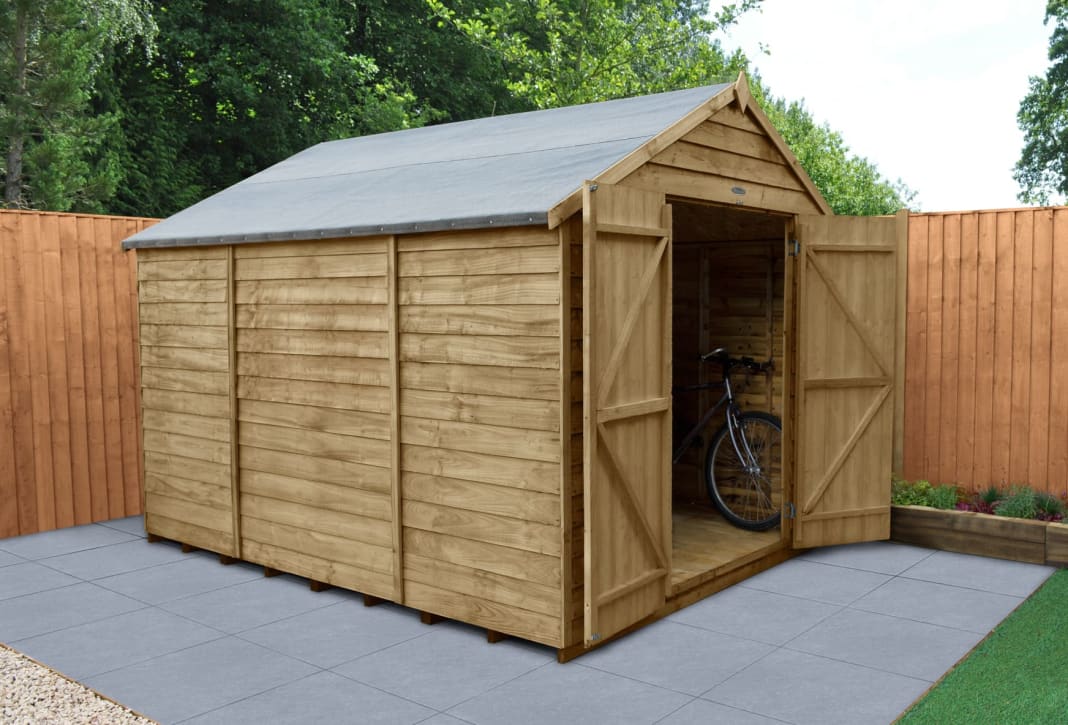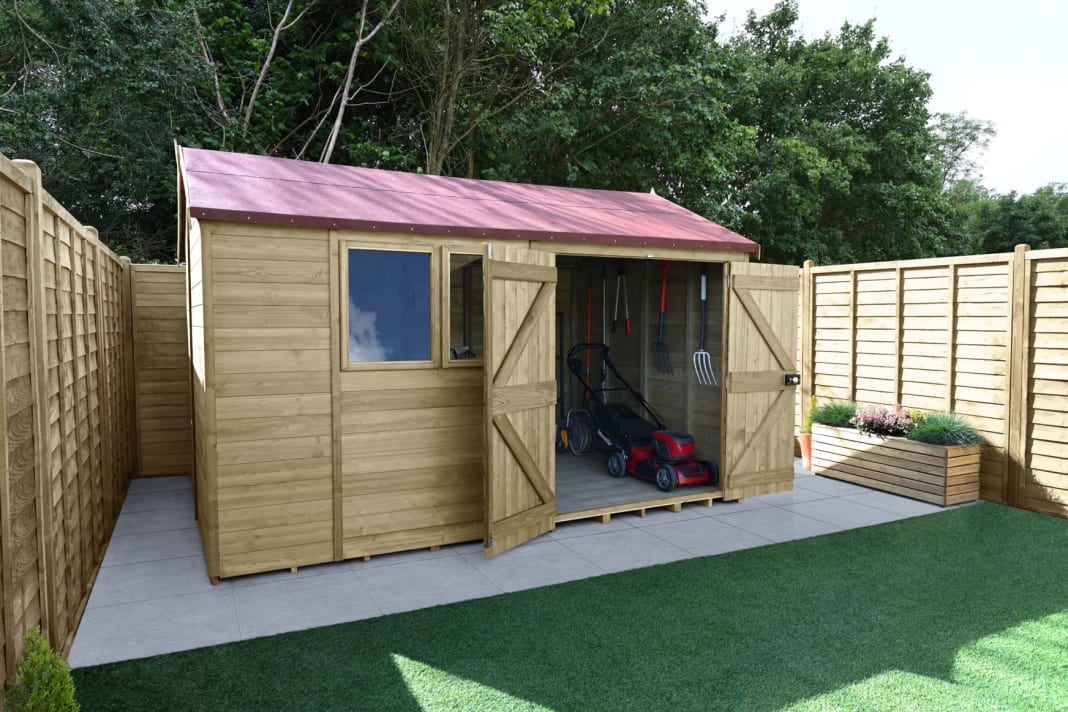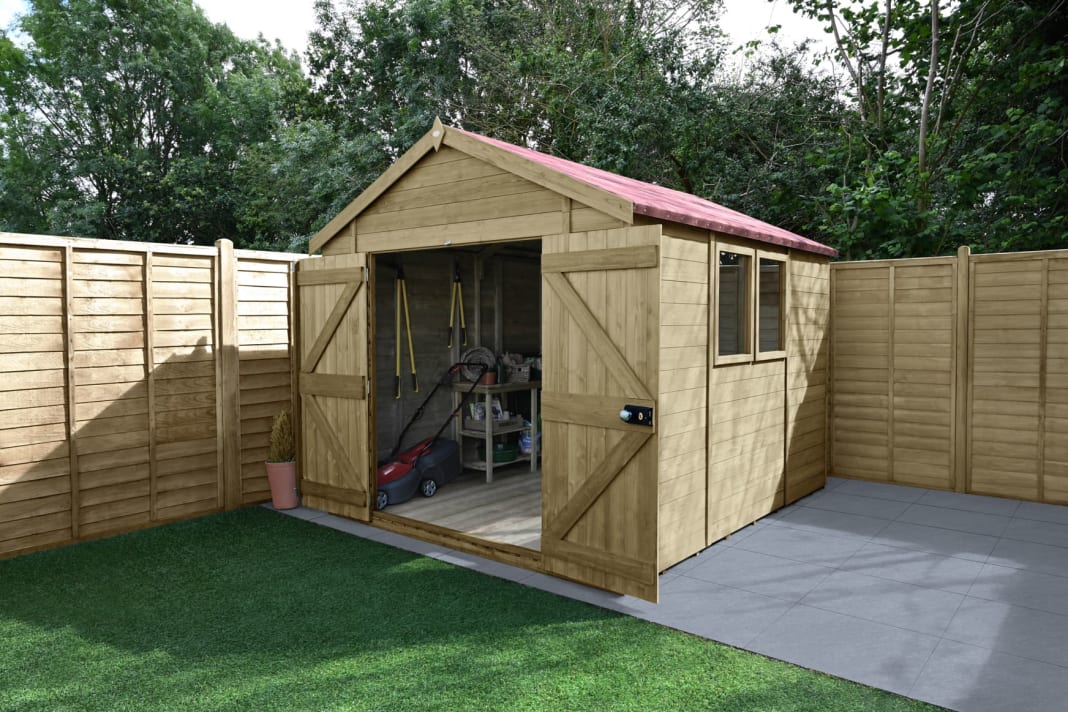Our Top 10 Tips for Buying the Perfect Wooden Shed
29 June 2022
Wooden sheds are our most popular type of garden shed. And it’s easy to see why. Strong, long lasting and incredibly stylish, a wooden shed is a treasured feature of many a British garden.
What to Look for When Buying a New Wood Shed
Buying the right wood shed can be a difficult decision, mainly because there are so many to choose from. But fear not because B&M’s shed experts have devised a 10-point plan to help you find your perfect model…
1) Shed Size
This will clearly be determined by the size of your garden and your budget (more about that later), but you should also consider how much you’re going to put in it.
It’s no good spending all of your money on a luxury 6x4 shed if you need garden storage for all of your outdoor furniture, the family’s bikes, plus your collection of tools and equipment. In this case, look for a larger but cheaper model. (Don’t be frightened of doing this because ALL B&M sheds are built to excellent standards.)
Also, consider this - everybody has a habit of somehow managing to fill their shed. Have you ever seen an empty one?! With this in mind, our advice is simple: go large…as large as you can!
2) Shed Usage
This is another key consideration. Do you need a shed for garden storage or are you intending to use it as a workshop for DIY projects? Perhaps a bit of both?
For anything other than purely garden storage, be sure to take a look at our workshop sheds and combination sheds, which offer you the best of both worlds.
3) Shed Cladding
Good wooden sheds usually come with 1 of 3 types of wall cladding:
Overlap Cladding
As the name suggests, overlap cladding is where the boards are nailed together horizontally, in an overlapping fashion. The walls’ thickness tends to start at (a perfectly-adequate) 7mm.
As overlap sheds are the easiest to manufacture, they tend to be the cheapest too. Price aside, their main selling point is that they provide excellent rainwater runoff.
Shiplap Cladding
Sometimes referred to as shiplap tongue and groove cladding, this is the mid-market choice. A tight, interlocking construction results in better insulation, less damp and a stronger shed.
You can recognise shiplap cladding by the large scalloped profile between its wooden boards.
Tongue and Groove Cladding
Tongue and Groove cladding shares the same tight, interlocking construction as shiplap but comes with less visible scallops and a sleeker, more contemporary finish. It is the most expensive option.
Both shiplap and tongue and groove cladding are usually (at least) 12mm thick.
Whatever type of cladding you choose, the general rule of thumb is the thicker, the better.
4) Shed Treatment
All wood sheds need to be treated against rot. When you come to buy, you will have 3 choices.
Dip Treatment
Here, the manufacturer dips the wood in a high-quality preservative. This is an effective form of treatment but you will need to retreat it, annually, in order to keep it protected.
Dip-treated sheds should be guaranteed against rot, subject to retreatment. The length of the guarantee varies, but can be anything up to 10 years.
Pressure Treatment
This involves forcing the treatment, under hydraulic pressure, deep inside the wood for outstanding levels of protection.
Pressure-treated sheds don’t usually require retreatment but always follow the manufacturer’s guidelines to be on the safe side. Many of our pressure-treated sheds come with long 15-year anti-rot guarantees with no retreatment required.
Overall, pressure-treated sheds are better protected than dip-treated models, but they’ll cost you more money.
Untreated Wooden Sheds
This needn’t be a red flag for you, providing that the manufacturer clearly states that treatment is required and that you’re willing to put the time and money in to do it as soon as the shed is assembled and annually, thereafter.
5) Roof Style
There are 4 main roof styles to choose from when buying a shed:
Apex Roofs
An apex roof is the traditional style, which we all know and love. It rises to form a high peak in the centre of the shed, which runs from one gable end to the other. The door is situated at one of the gable ends.
The main advantage of an apex roof is that it offers extra headroom/ storage space in the centre of the shed.
Reverse Apex Roofs
These shed roofs follow the same principle as apex models but the door is positioned on one of the longer sides.
The layout of reverse apex sheds tends to make them great garden workshops.
Pent Roofs
A pent roof doesn’t have a peak and gently slopes from one side to the other. The main advantage here is that it makes the shed easier to site under trees or alongside a fence.
Pent roofs are seen as being the most fashionable.
Lean-To Sheds
These are exactly the same as pent roofs, but are designed to slope away from an adjacent wall or fence.
6) Doors and Windows
When it comes to door and window numbers, styles and placements, we’re sure you’ll know exactly what you need. However, something you might not have heard about, and which is certainly worth considering, is a modular shed…
7) Modular Sheds
Not only do modular sheds give you the flexibility to choose your own door and window placements, they also come in smaller sections with more wood, making for an easier assembly and much stronger build.
We love modular sheds and stock an excellent range of them.
8) Shed Floor and Roof Material/ Thickness
There are 3 main choices of floor and roof material:
OSB
OSB, sometimes referred to as solid sheet, is probably the type of flooring and roofing found in your old shed. It starts at about 8mm thick, is the cheapest option, but perfectly adequate for most purposes.
Tongue and Groove
A tongue and groove floor or roof is the luxury choice. Not only is it invariably thicker than OSB, it is stronger, longer lasting, more stylish and has better weatherproof qualities too. Tongue and Groove flooring, in particular, is the perfect option if you’re storing heavier tools or machinery.
Solid Wood
The third option is usually just referred to as solid wood (or words to that effect). Here, look for the thickness. Anything from 12mm upwards for a floor, and 10mm upwards for a roof, is a sign of good quality.
9) Shed Brand
This is where we’ve made it easy for you because, as you will see from our stock, we favour 1 particular manufacturer of wooden sheds, whom we believe to be the best on the market and whom produces every conceivable type of shed that you will ever require, amongst their market-leading ranges:
Forest Garden
Forest is the UK’s leading manufacturer of wooden garden sheds. They specialise in premium wooden sheds, with very long guarantees, at highly-competitive prices. Their choice of wooden sheds is huge. If Forest don’t make it, it’s not worth making.
That is why we recommend Forest wooden sheds!
10) Shed Price
This one’s the biggie, isn’t it? Look, you know how much money you’ve got to play with but remember this…nobody beats B&M on price.
So, for the best wooden sheds at the most competitive prices, always shop B&M Garden Buildings. And what's more you can get free delivery* and pick your delivery date!
*Please note that there are delivery surcharges for a few remote postcodes. T&Cs apply.
Got any tips of your own when it comes to buying wooden sheds? Have you bought one of our wooden garden sheds recently? We'd love to see how it looks! Share your tips and buys with the B&M Community on Facebook, Twitter & Instagram.









